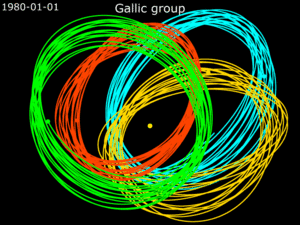Astronomy:Saturn's Gallic group of satellites
The Gallic group is a dynamical grouping of the prograde irregular satellites of Saturn following similar orbits. Their semi-major axes range between 16 and 19 Gm, their inclinations between 35° and 40°, and their eccentricities around 0.53.

The International Astronomical Union (IAU) reserves names taken from Gallic mythology for these moons.
Similar mean orbital elements led the discoverers to postulate a common origin for the group in a breakup of a larger body.Cite error: Closing </ref> missing for <ref> tag Such an impact would require a body with the diameter in excess of 1 km and relative velocity close to 5 km/s, resulting in a large crater with the radius of 12 km. Numerous, very large craters observed on Phoebe, prove the existence of such collisions in the Saturnian system's past.
The discovery of 20 new moons of Saturn was announced in October 2019 by a team led by Scott S. Sheppard using the Subaru Telescope at Mauna Kea. One of them, S/2004 S 24, is also prograde, but it orbits much further away from Saturn than the four known Gallic moons. This moon will nevertheless also receive a name from Gallic mythology.[1]
The four members of the group discovered before 2019 are (in order of increasing distance from Saturn):
See also
References
- ↑ Saturn surpasses Jupiter after the discovery of 20 new moons—and you can help name them, NASA, phys.org, October 7, 2019
External links


